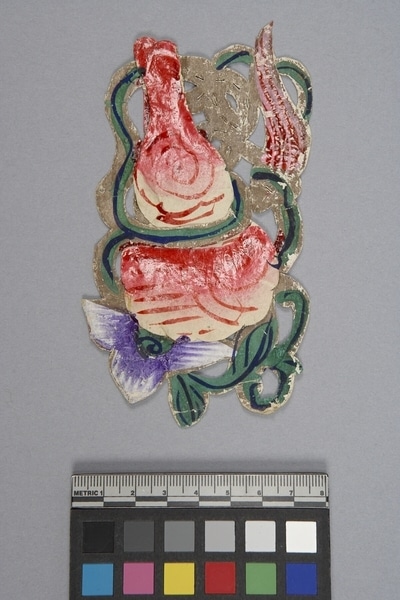Firecracker Label Item Number: 822/2 from the MOA: University of British Columbia

Description
Firecracker paper with a red and white vase-shaped, slightly convex piece of paper glued to paper cut into the shape of a purple flower with tangled foliage. The paper is painted.
History Of Use
Invented in China around the 12th century or earlier, firecrackers have been widely used in China to serve a variety of religious and secular purposes. In both the past and present, firecrackers are used to ward off evil spirits, to honour spirits and deities, and to mark special occasions such as weddings, birthdays, funerals, shop openings, or festivals. Firecrackers are by far in greatest demand during the annual Lunar New Year, when they are ignited to purify a space and to blast away negative energies and demons. Firecrackers are also used in “fengshui” geomantic practices, as ritual objects to be hung in the home to stimulate new beginnings, prosperity, and the protection of the household. A large number of firecracker labels were produced from approximately 1850-1910, in the Guangdong region of southern China, to decorate the wooden crates that they were shipped in. Since many of these were produced in Foshan (Fatshan), a city noted for its manufacture of handmade ritual goods, collectors often refer to them as “Fat Shan” labels. They range in size from smaller four-inch squares to larger circular labels with a twenty-four inch diameter. The labels are colourfully painted with auspicious themes, including depictions of deities, legends and myths, historical narratives, and scenes of everyday life. The images enhance the fireworks’ role in dispelling evil while attracting virtue and prosperity. These labels were widely sold in south-central and south-west China, and south-east Asia. Local manufacturers and merchants would order bulk firecrackers, pack them into wooden crates, and decorate the crates with these labels to entice potential distributors and consumers. Aside from their use as firecracker labels, many people in south China used the labels to decorate their rooms and utensils. Few labels survived to today because of their fragility and the small value placed on them at the time. After 1910, these painstaking production techniques were gradually replaced by lithography machines, which allowed artisans to print full colour labels on rice paper.
Iconographic Meaning
This firecracker label depicts a pink “bottle-gourd” (hulu), one of the eight symbols associated with each of the Eight Immortals. The bottle gourd is associated with the immortal Li Tieguai, a benefactor of the poor, sick, and disenfranchised. The gourd is traditionally used to carry medicinal ingredients or potions. They also serve as important auspicious and sacred symbols in Chinese art, with many layers of meaning, including fertility, prosperity, immortality, and healing. The character for gourd (hulu) is a homophone for "protection" (hu) and a pun for “prosperity” (fu). It is likely that this particular label belongs to a set of eight, with each depicting one of the eight symbols of the Eight Immortals. There are five such labels, including this example, in MOA’s collection.
Item History
- Made in China
- Owned by T & N Company before October 19, 1982
- Received from Museum of Anthropology Shop Volunteers (Funding source) and T & N Company (Seller) on October 19, 1982
What
- Name
- Firecracker Label
- Identification Number
- 822/2
- Type of Item
- label
- Overall
- height 7.5 cm, width 13.1 cm, depth 0.3 cm
Who
- Culture
- Chinese
- Previous Owner
- T & N Company
- Received from
- Museum of Anthropology Shop Volunteers (Funding source) and T & N Company (Seller)
Where
- Holding Institution
- MOA: University of British Columbia
- Made in
- China
When
- Ownership Date
- before October 19, 1982
- Acquisition Date
- on October 19, 1982
Other
- Item Classes
- works on paper
- Condition
- good
- Accession Number
- 0822/0002